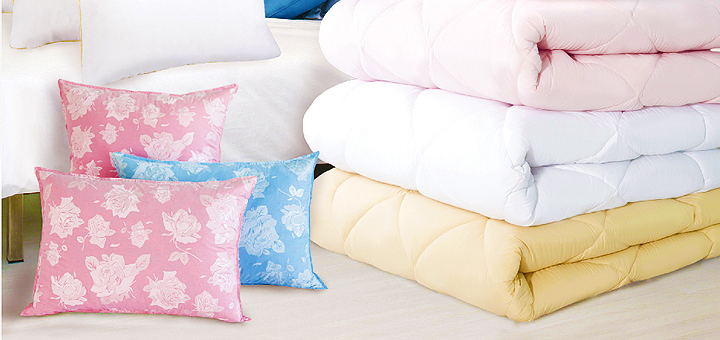
BLANKETS
Description of blankets
The following materials are used as the top layer for bed blankets:
100% cotton;
cotton and linen materials: teak, twill, batiste, satin, percale;
satin jacquard;
80% cotton + 20% polyester;
silk;
combination of silk and cotton;
rarely artificial materials such as fleece or modal.
The fabric is selected depending on the filler. It goes like this:
down – goose, duck or loons are used;
wool – sheep, camel, cashmere;
cotton – cotton wool of various density;
silk – fluffy protein filaments of the silkworm;
bamboo – natural recycled fiber;
synthetic materials: holofiber, synthetic winterizer, silicone, thinsulate (simulator of swan’s down), viscose, comforel, microfiber;
It should be noted that almost all fillers are hypoallergenic (except for wool and down), light and breathable. Synthetic viscose and natural silk have disadvantages – they are electrified
Artificial material is used as a filler.
A light weight.
It is recommended to use in the winter time.
Low hygroscopicity.
Do not accumulate static electricity.
Keep warm.
Dust mites do not start in the filler.
Hypoallergenic.
Can be washed in a machine.
Light and airy, pleasant and comfortable for the body.
With proper use and care, a thing can last up to 20 years.
Natural wool is an environmentally friendly product that has a positive effect on human health.
They promote air circulation, the body has the opportunity to breathe, and the formation of the greenhouse effect is prevented.
Products made from natural materials are wear-resistant and durable.
Body temperature is kept relatively constant under the wool product, which allows it to be used at any time of the year.
Healing effect: improves blood circulation and metabolism.
Classification of blankets by size:
One and a half standard 1 – 145×205 cm;
One and a half standard 2 – 150×220 cm;
Double – 175×205 cm;
Double, old standard – 170×210 cm;
Euro standard – 200×220 cm;
Royal standard – 220×240 cm;
Baby for the crib – 90×120 cm;
The warming properties of blankets on the packages are displayed as dots, the warmer the product, the more of them:
very warm – 5;
warm – 4;
semi-warm (demi-seasonal) – 3;
lung – 2;
very light – 1 point.
Density:
150-220g/sqm is a low weight that indicates a lightweight duvet, suitable for hot summer or warm spring/autumn.
280-300gsm are duvets that are suitable for all seasons except warm summer nights.
420 g/sq.m are the warmest blankets for cold winters and people who are cold in their sleep.
Description of bed linen.
Bedding is an important attribute of a comfortable sleep, making the sleeping place pleasant to the touch and beautiful, protecting the mattress, pillows and blankets from scuffs and dirt. Usually it is a set of quality fabrics, including a sheet, 2 pillowcases, 1 or 2 duvet covers.
Modern bedding is made from a variety of fabrics, from classic silk, cotton and linen to the latest and increasingly popular bamboo and tencel (eucalyptus fibre). Sets of the proposed materials have their own advantages, indicators of hygroscopicity, strength and smoothness, can warm or cool, have a positive effect on the skin and heal.
materials
Modern bedding is sewn from various materials. The choice of the optimal option is carried out on the basis of key factors – seasonality, destination and cost.
Fabrics for tailoring products are divided into three categories: natural, synthetic and blended.
Cotton materials
They differ in fiber thickness and weaving method.
Coarse calico
A popular type of cotton fabric used to make home textiles. Due to the dense weaving of the threads, the coarse calico turns out to be rough to the touch. It has a smooth and shiny surface. Suitable for sewing adult sets.
It is unpretentious in leaving, maintains repeated washings in the automatic machine. Linen made of cotton calico does not wrinkle and does not lose color brightness even after prolonged use.
satin
It is made from cotton fibers with a special weave. Thanks to this, satin acquires an attractive glossy sheen and a silky surface. The underside of the material has some roughness. The dense weaving of the threads prevents color fading, deformation and shrinkage of the material during frequent washing.
Satin sets can withstand up to 300 washes in the washing machine.
chintz
Lightweight and cheap cotton fabric used for making linen. The special weaving of the threads provides additional friability to the material, so it is breathable and pleasant to the touch.
Of great importance is the method of decorative finishing, due to which the products become soft, dense, hard, matte or glossy. Chintz products are suitable for daily use.
Cotton Batiste
Made from cotton raw materials, has something


